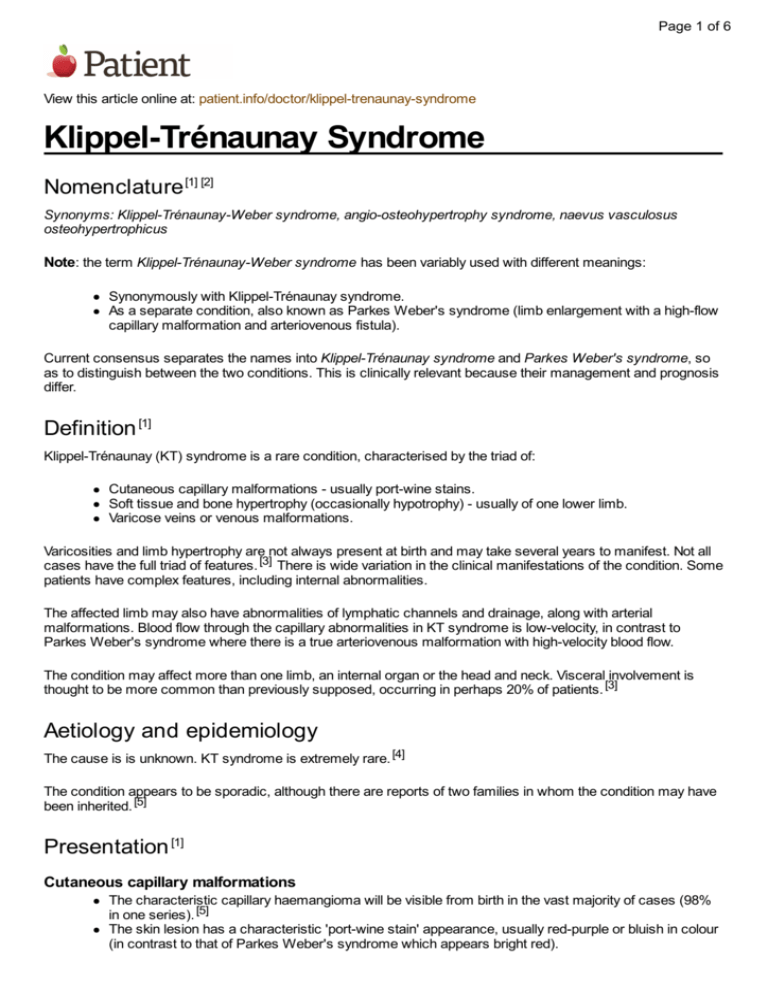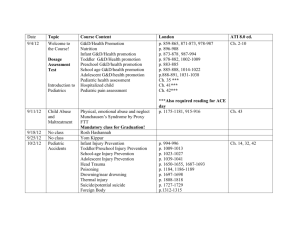
Page 1 of 6
View this article online at: patient.info/doctor/klippel-trenaunay-syndrome
Klippel-Trénaunay Syndrome
Nomenclature [1] [2]
Synonyms: Klippel-Trénaunay-Weber syndrome, angio-osteohypertrophy syndrome, naevus vasculosus
osteohypertrophicus
Note: the term Klippel-Trénaunay-Weber syndrome has been variably used with different meanings:
Synonymously with Klippel-Trénaunay syndrome.
As a separate condition, also known as Parkes Weber's syndrome (limb enlargement with a high-flow
capillary malformation and arteriovenous fistula).
Current consensus separates the names into Klippel-Trénaunay syndrome and Parkes Weber's syndrome, so
as to distinguish between the two conditions. This is clinically relevant because their management and prognosis
differ.
Definition [1]
Klippel-Trénaunay (KT) syndrome is a rare condition, characterised by the triad of:
Cutaneous capillary malformations - usually port-wine stains.
Soft tissue and bone hypertrophy (occasionally hypotrophy) - usually of one lower limb.
Varicose veins or venous malformations.
Varicosities and limb hypertrophy are not always present at birth and may take several years to manifest. Not all
cases have the full triad of features. [3] There is wide variation in the clinical manifestations of the condition. Some
patients have complex features, including internal abnormalities.
The affected limb may also have abnormalities of lymphatic channels and drainage, along with arterial
malformations. Blood flow through the capillary abnormalities in KT syndrome is low-velocity, in contrast to
Parkes Weber's syndrome where there is a true arteriovenous malformation with high-velocity blood flow.
The condition may affect more than one limb, an internal organ or the head and neck. Visceral involvement is
thought to be more common than previously supposed, occurring in perhaps 20% of patients. [3]
Aetiology and epidemiology
The cause is is unknown. KT syndrome is extremely rare. [4]
The condition appears to be sporadic, although there are reports of two families in whom the condition may have
been inherited. [5]
Presentation [1]
Cutaneous capillary malformations
The characteristic capillary haemangioma will be visible from birth in the vast majority of cases (98%
in one series). [5]
The skin lesion has a characteristic 'port-wine stain' appearance, usually red-purple or bluish in colour
(in contrast to that of Parkes Weber's syndrome which appears bright red).
Page 2 of 6
Venous malformations and varicosities
These are mostly superficial, but may involve muscle, bone or visceral organs, including the spleen,
liver, pleura, bladder or colon.
They may be extensive in the affected limb.
They usually manifest when the child starts walking.
There may be lymphatic hypoplasia or aplasia with resulting lymphoedema. This can complicate the
condition and contribute to the limb enlargement.
Limb abnormalities
Limb lengthening may present initially as gait disturbance.
Limb hypertrophy is often greater distally. The digits may be affected, with macrodactyly, syndactyly,
polydactyly or oligodactyly.
An increase in limb girth may be the main feature if soft tissues rather than bones are predominantly
affected.
Rarely, the affected limb may show atrophy rather than hypertrophy.
Complications [1]
Psychological problems due to cosmetic appearance.
Chronic venous stasis and its complications:
Venous dermatitis, venous ulcers.
Chronic paraesthesiae.
Venous thromboembolism (VTE).
Thrombophlebitis.
Kasabach-Merritt syndrome (consumptive coagulopathy) can occur with large
haemangiomas. [6] [7]
Visceral bleeding: [3] [8]
Page 3 of 6
Visceral bleeding: [3] [8]
This ranges from occult to massive and life-threatening.
It usually presents in childhood.
The most common sites of gastrointestinal bleeding are the distal colon and rectum. Other
sites, such as jejunal vascular malformations and oesophageal varices, are reported.
Splenic haemangiomas may occur.
Genitourinary:
Bladder lesions may cause frank haematuria (usually in childhood; recurrent and
painless). [3]
Erectile dysfunction due to disturbance of venous function. [9]
Orthopaedic complications:
Gait disturbance.
Scoliosis.
Chronic pain in the affected limb.
Haemangiomas of the liver, kidney, heart or lungs have also been reported. [3]
One reported case involved a cerebral haemangiopericytoma (a malignant vascular tumour). [10]
Differential diagnosis [11]
Parkes Weber's syndrome (where there is a high-flow arteriovenous malformation rather than capillary
haemangioma, as above).
Other syndromes involving port-wine stains and high-flow shunts - eg, capillary malformationarteriovenous malformations syndrome, Cobb's syndrome and CLOVES syndromes (Congenital
Lipomatous Overgrowth, Vascular malformations, Epidermal naevi and
Spinal/scoliosis/seizures/skeletal abnormalities).
Sturge-Weber syndrome.
Proteus' syndrome (rare hamartomatous disorder causing asymmetrical hypertrophy of a range of
tissues, possibly afflicting Joseph Merrick, the so-called 'Elephant Man').
Congenital lymphatic atresia or obstruction.
Maffucci's syndrome (rare dysembryoplasia causing cartilage and vessel tumours).
Kaposiform haemangioendothelioma.
Investigations [3] [12] [13]
Investigation of the vascular or lymphatic malformations - various methods may be used; for example:
Doppler ultrasound.
Angiography or MRI/CT angiography.
MRI or CT.
CT of the abdomen and pelvis may help to identify visceral haemangiomas. [3]
Whole-body blood pool scintigraphy.
Lymphoscintigraphy may be used to assess the lymphatic system and the cause of limblength discrepancy.
Imaging of the bone and soft tissues of the affected limb, using plain X-rays, MRI or CT scan.
If there is gastrointestinal bleeding, it may be difficult to locate the source by endoscopy, since the
venous malformations can be widely spread. Angiography can be helpful for both diagnosis and
treatment of these lesions and has been used to locate and treat severe bleeding in one reported
case. [8]
Management [1]
There is no curative therapy. Management requires a multidisciplinary and individualised approach, aiming to
ameliorate the patient's symptoms and correct the consequences of limb-length discrepancy. [14]
Page 4 of 6
Conservative measures
Graduated compression garments help to reduce the effect of chronic venous insufficiency in the
affected limb. Intermittent pneumatic compression pumps may also be used to the same effect.
These help to reduce the effects of venous insufficiency but do not affect the ultimate size of the limb.
Prophylaxis for VTE may be appropriate.
Standard treatments for cellulitis or thrombophlebitis.
Pain management.
Contraception: oestrogen-containing contraceptives are contra-indicated where there is a history of
VTE and should probably be avoided in KT syndrome because of the increased VTE risk (although
there is no specific UK contraception guideline for this condition).
Pregnant women with KT syndrome need careful monitoring due to a range of haematological,
obstetric and anaesthetic complications. [15]
Active/surgical measures
Laser treatment (pulsed dye laser) for cosmetic improvement of head and neck cutaneous lesions.
Pre-operative assessment:
Detailed pre-operative assessment of the venous system is important because there may
be associated hypoplasia of the deep veins. [13]
Careful anaesthetic assessment is required, including for possible consumptive
coagulopathy. [7] [16]
Surgery for long bone fractures in the affected limbs is associated with high risk due to
increased haemorrhage. This requires careful pre-operative planning, surgical technique
and intra-operative/postoperative support. [17]
Vascular interventions:
Treatment of the more severe venous malformations may include:
Sclerotherapy with foam or with alcohol. [18]
Vascular surgery such as:
Surgical stripping.
Phlebectomy.
Subfascial endoscopic ligation of perforating veins. [13]
Endovenous thermal ablation. [14]
Rarely, deep venous reconstruction. [13]
Gastrointestinal bleeds may require angiographic treatment - eg, selective arterial
embolisation has been used in one case; or intra-arterial infusion of vasopressin has been
suggested. [8] Surgical resection of the bowel may be required. [3]
For splenic haemangiomas, small ones (<4 cm) have been managed conservatively;
splenectomy may be considered for larger lesions. [3]
Erectile dysfunction has been successfully treated by ligation of the affected veins. [9]
Orthopaedic interventions:
Limb length discrepancy may be treated with orthoses or orthopaedic surgery, depending
on its severity.
De-bulking surgery for grossly enlarged limbs is occasionally used but carries a significant
risk of lymphatic and venous damage.
Amputation may be used in cases where a limb or digit is of little functional use and causes
severe symptoms or complications.
Prognosis
Life expectancy is largely normal, depending on the severity of the malformation and thus the likelihood
of complications. [1]
Possibly about 10% of patients develop a pulmonary embolism.
Further reading & references
Klippel-Trenaunay-Weber syndrome; Geneva Foundation for Medical Education and Research
Schook CC, Mulliken JB, Fishman SJ, et al; Differential diagnosis of lower extremity enlargement in pediatric patients
referred with a diagnosis of lymphedema. Plast Reconstr Surg. 2010 Dec 23.
Page 5 of 6
1. Meier S; Klippel-Trenaunay syndrome: a case study. Adv Neonatal Care. 2009 Jun;9(3):120-4.
2. Klippel-Trenaunay Support Group
3. Kocaman O, Alponat A, Aygun C, et al ; Lower gastrointestinal bleeding, hematuria and splenic hemangiomas in Turk J
Gastroenterol. 2009 Mar;20(1):62-6.
4. Sung HM, Chung HY, Lee SJ, et al; Clinical Experience of the Klippel-Trenaunay Syndrome. Arch Plast Surg. 2015
Sep;42(5):552-8. doi: 10.5999/aps.2015.42.5.552. Epub 2015 Sep 15.
5. Klippel-Trenaunay-Weber Syndrome; Online Mendelian Inheritance in Man (OMIM)
6. Holak EJ, Pagel PS; Successful use of spinal anesthesia in a patient with severe Klippel-Trenaunay syndrome associated
with upper airway abnormalities and chronic Kasabach-Merritt coagulopathy. J Anesth. 2010 Feb;24(1):134-8.
7. Beier UH, Schmidt ML, Hast H, et al; Control of disseminated intravascular coagulation in Klippel-Trenaunay-Weber
syndrome using enoxaparin and recombinant activated factor VIIa: a case report. J Med Case Reports. 2010 Mar 19;4:92.
8. Wang ZK, Wang FY, Zhu RM, et al; Klippel-Trenaunay syndrome with gastrointestinal bleeding, splenic hemangiomas and
left inferior vena cava. World J Gastroenterol. 2010 Mar 28;16(12):1548-52.
9. Agrawal V, Minhas S, Ralph DJ; Venogenic erectile dysfunction in Klippel-Trenaunay syndrome. BJU Int. 2006
Feb;97(2):327-8.
10. Mathews MS, Kim RC, Chang GY, et al; Klippel-Trenaunay syndrome and cerebral haemangiopericytoma: a potential
association. Acta Neurochir (Wien). 2008 Apr;150(4):399-402; discussion 402. Epub 2008 Feb 25.
11. Alomari AI; Atruly unusual overgrowth syndrome: an alternative diagnosis to Klippel-Trénaunay-Weber syndrome. Intern
Med. 2009;48(6):493-4; author reply 495. Epub 2009 Mar 16.
12. Funayama E, Sasaki S, Oyama A, et al; How do the type and location of a vascular malformation influence growth in
Klippel-Trénaunay syndrome? Plast Reconstr Surg. 2011 Jan;127(1):340-6.
13. Mavili E, Ozturk M, Akcali Y, et al; Direct CT venography for evaluation of the lower extremity venous anomalies of KlippelTrenaunay Syndrome. AJR Am J Roentgenol. 2009 Jun;192(6):W311-6.
14. Gloviczki P, Driscoll DJ; Klippel-Trenaunay syndrome: current management. Phlebology. 2007;22(6):291-8.
15. Sivaprakasam MJ, Dolak JA; Anesthetic and obstetric considerations in a parturient with Klippel-Trenaunay syndrome. Can
J Anaesth. 2006 May;53(5):487-91.
16. Pereda Marin RM, Garcia Collada JC, Garrote MartinezAI, et al; Anesthetic management of Klippel-Trénaunay syndrome
and attendant gastrointestinal hemorrhage. Acase report. Minerva Anestesiol. 2007 Mar;73(3):187-90. Epub 2006 Dec 12.
17. Tsaridis E, Papasoulis E, Manidakis N, et al; Management of a femoral diaphyseal fracture in a patient with KlippelTrenaunay-Weber syndrome: a case report. Cases J. 2009 Aug 26;2:8852.
18. Parashette KR, Cuffari C; Sclerotherapy of rectal hemangiomas in a child with Klippel-Trenaunay-Weber syndrome. J
Pediatr Gastroenterol Nutr. 2011 Jan;52(1):111-2.
Disclaimer: This article is for information only and should not be used for the diagnosis or treatment of medical
conditions. EMIS has used all reasonable care in compiling the information but make no warranty as to its
accuracy. Consult a doctor or other health care professional for diagnosis and treatment of medical conditions.
For details see our conditions.
Original Author:
Dr Sean Kavanagh
Current Version:
Dr Colin Tidy
Peer Reviewer:
Dr Adrian Bonsall
Document ID:
1679 (v26)
Last Checked:
19/01/2016
Next Review:
17/01/2021
View this article online at: patient.info/doctor/klippel-trenaunay-syndrome
Discuss Klippel-Trénaunay Syndrome and find more trusted resources at Patient.
Page 6 of 6
© EMIS Group plc - all rights reserved.







